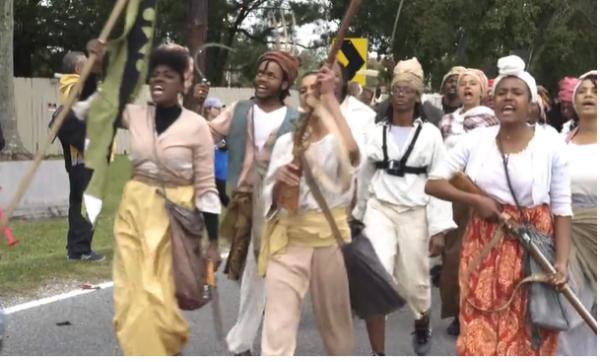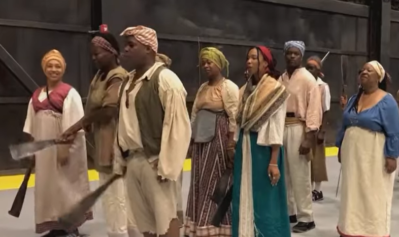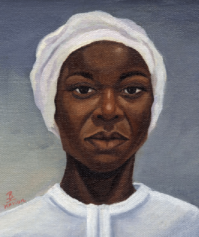This weekend saw hundreds of reenactors descend on a small town in Louisiana where what’s considered to be the biggest slave revolt in U.S. history occurred more than 200 years ago.
Described on the official website as “a community-engaged artist performance and film production,” Slave Rebellion Reenactment marched through LaPlace, Louisiana Nov. 8-9. As the actors made the 26-mile march in dress that was fit for the early 19th century, they recreated the German Coast Uprising of 1811. The event is a little-known incident that saw slaves on Andry plantation, which is located just outside New Orleans, rise up against their white slave master, take up arms and head toward the city. During the trek that evolved to include hundreds, NPR reported the goal was to free every slave along the way and take over Nola.
The event began Friday, Nov. 8 and was helmed by New York-based artist Dread Scott, who the Los Angeles Times reported was born Scott Tyler but goes by a close approximation of the name of the 1800s-era slave who unsuccessfully sued for his freedom, Dred Scott. The artist organized the march that was also filmed for a documentary by Ghanaian-British filmmaker/writer John Akomfrah.
“It’s a project about freedom and emancipation,” Scott told the newspaper ahead of the march. “People study George Washington and Thomas Jefferson, who were enslavers. Why are their ideas of democracy studied, instead of these people who were trying to get to a society that didn’t have slavery at its foundation? … These people were heroes.”
Footage captured from the march saw people marching through the streets chanting such things as “Freedom or Dead!,” “We’re going to end slavery! Join us!” and “Freedom!”
It’s noted on the SRR website that littler skirmishes actually occurred during the revolt, so those reenacting the event didn’t engage in tons of fights. Still, the L.A. Times reported that historians are not of one accord when it comes to the events that took place more than two centuries ago. The majority of historical documents show that the rebels did not kill plantation owner Andry himself, but they succeeded in killing his son. However, a single New Orleans historian remains firm that Andry’s son died before enslaved men and women revolted.

And while the reenactment largely followed what is known of history, Scott elected to change the ending that Artnet reported involved nearly 100 black people’s heads being plopped atop pikes.
Instead, Scott arranged a late-day battle that saw rebelling slaves confront the white militia and pushed them back. Scott believes that the revolt “had a chance of success,” which led day two of the reenactment to see the enslaved militia lauding their triumph smack dab in the middle of The Big Easy.
For Scott, however, he wants the march to serve as a way for conversations to be spurred surrounding concerns that typically cause disagreement.
He told NPR, “Why for 21st-century people does this 19th-century history of freedom and emancipation — why does it matter? How can we draw on the lessons of these heroes from 1811 to actually embody that now and actually re-imagine how we get free today?”


